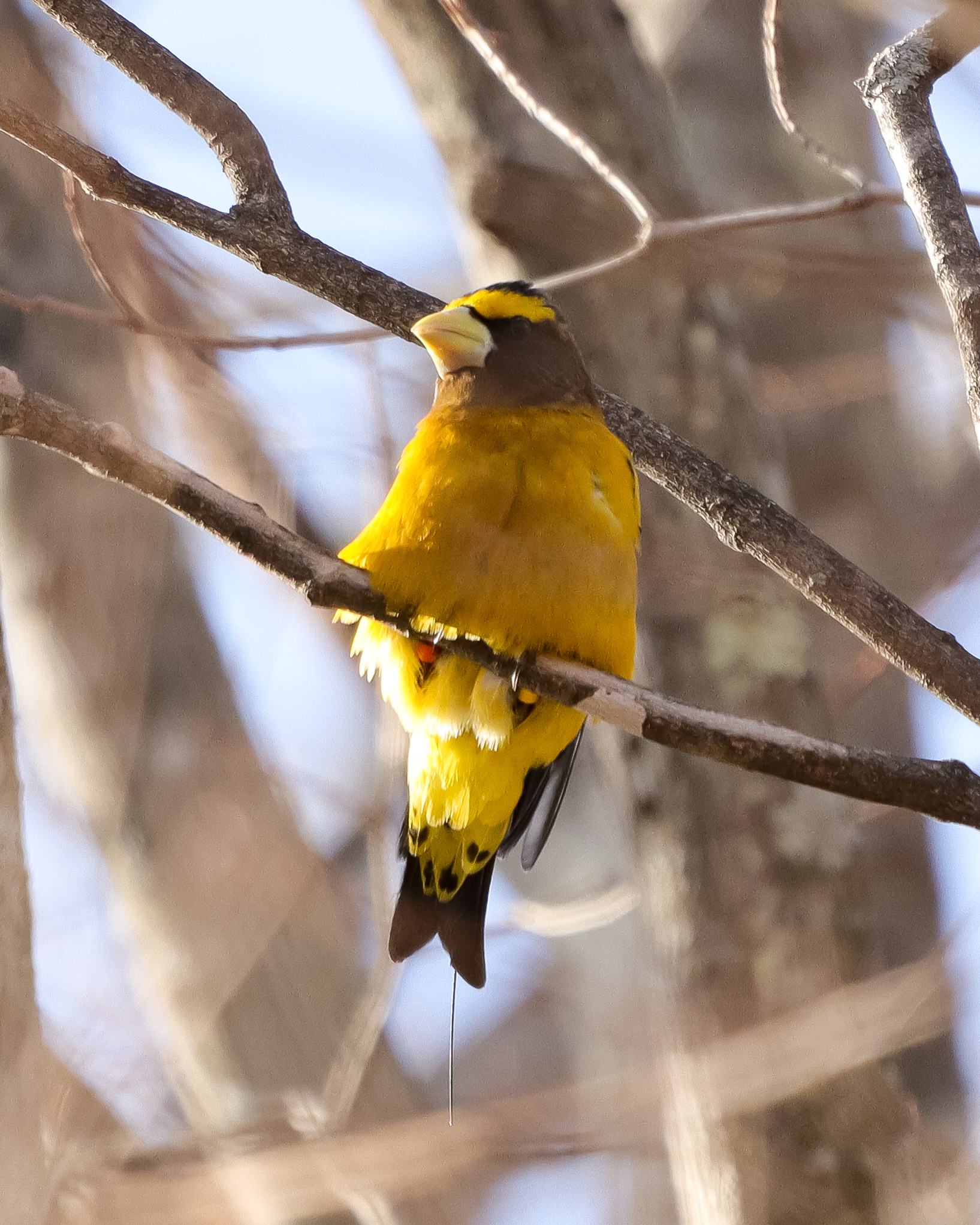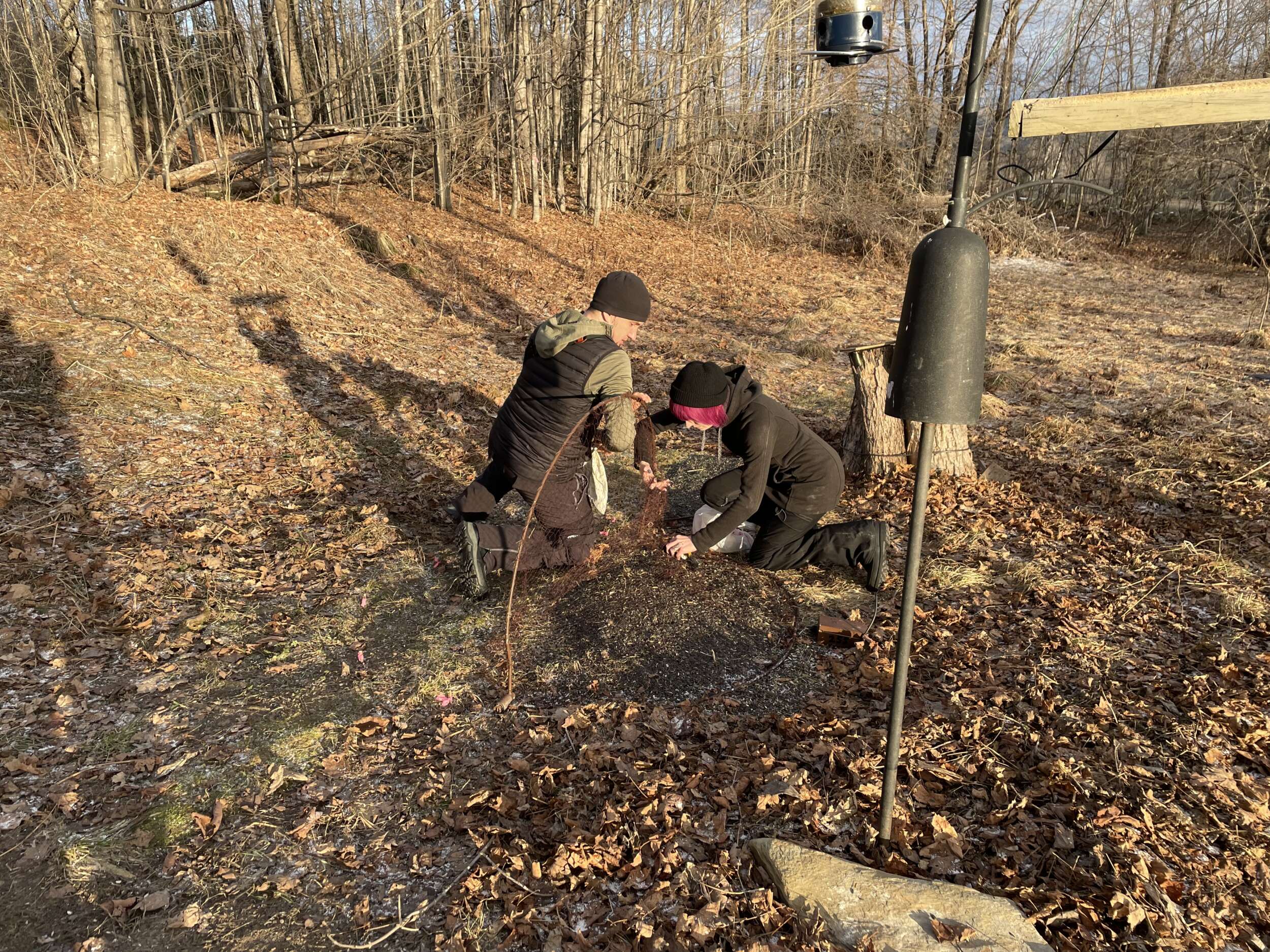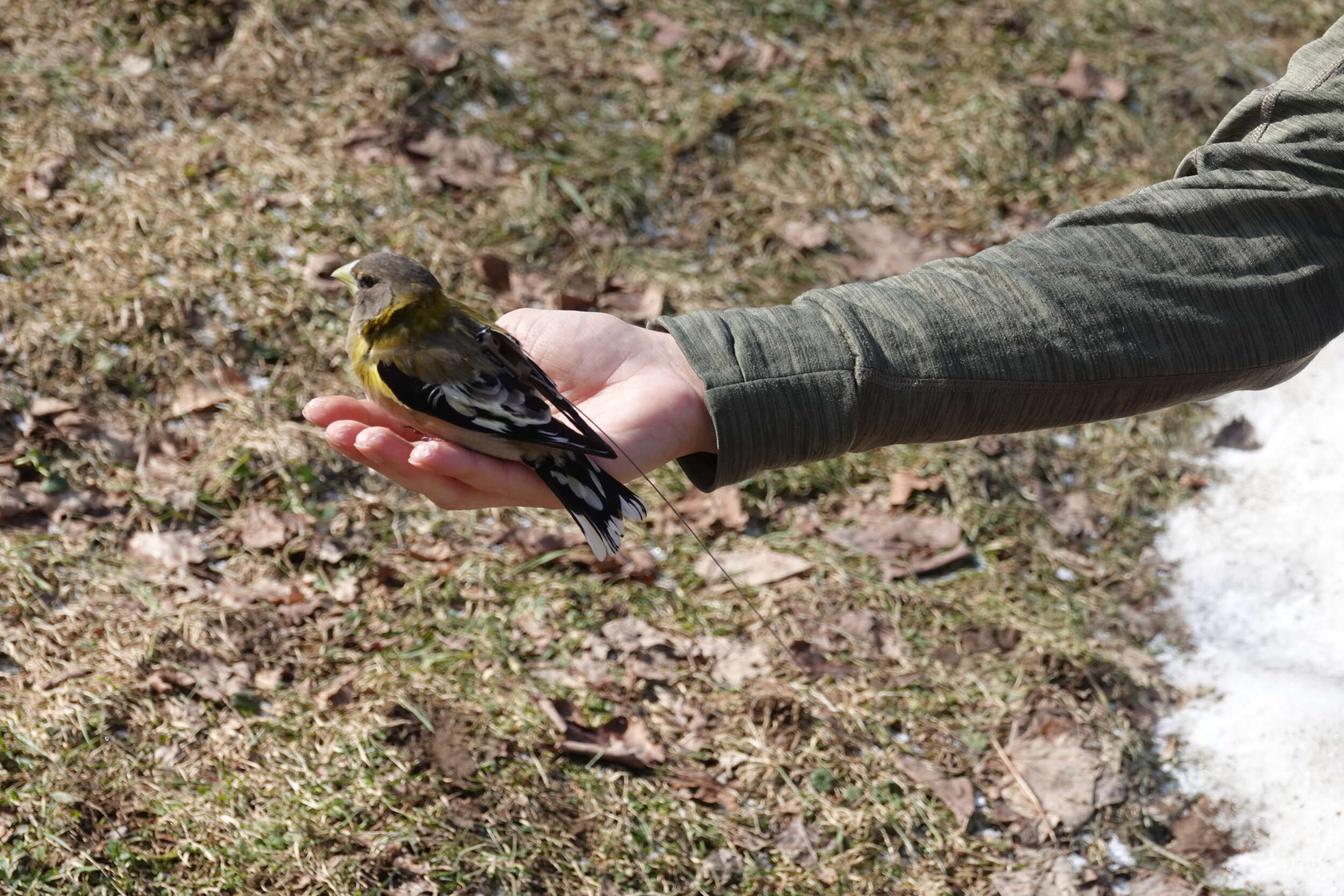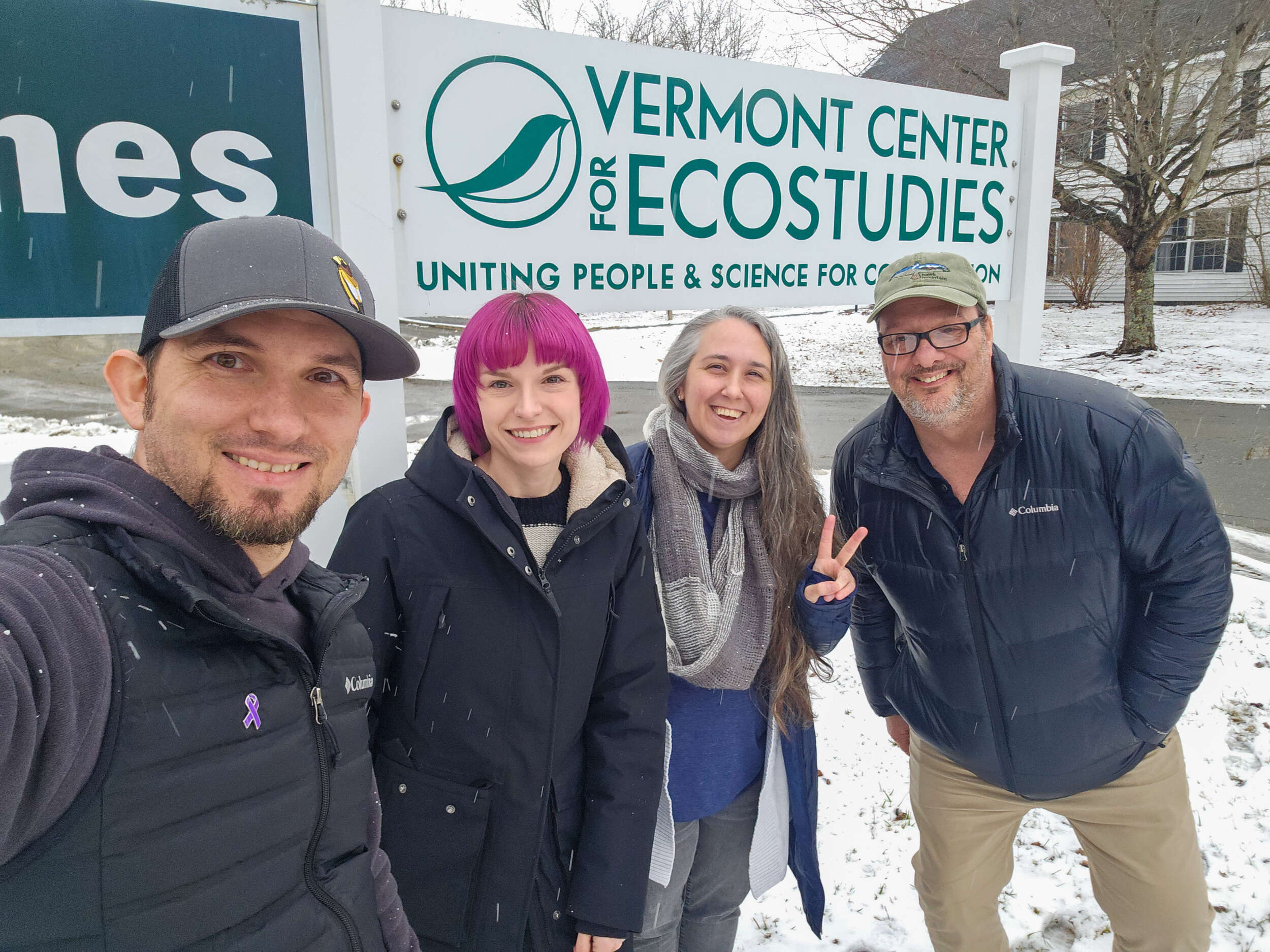 On Sunday morning in late March, as I was taking my dog out for her morning walk, I heard one of my favorite sounds of Vermont winters: ‘wheer wheer’! That’s the call of the Evening Grosbeak, a chunky black and gold finch that in some years graces my feeders.
On Sunday morning in late March, as I was taking my dog out for her morning walk, I heard one of my favorite sounds of Vermont winters: ‘wheer wheer’! That’s the call of the Evening Grosbeak, a chunky black and gold finch that in some years graces my feeders.
But this Sunday was different from my usual weekend sightings—I had a few human visitors in town. David Yearny from the Pennsylvania Natural Heritage Program, Mallory Sarver from Powdermill Avian Research Center, and Matt Young from the Finch Research Network (FiRN) were hoping to capture these grosbeaks for a large, multi-state research study. They are leading a team of researchers nationwide in a race to understand one of North America’s fastest declining songbirds.
Evening Grosbeaks spend both the breeding and wintering seasons in Vermont. Secretive during breeding, they are much more likely to be seen in the Green Mountain State during the winter, when they visit feeders in loud, noisy flocks.
About the size of a robin, these chunky birds have flashes of yellow on gray for the females and yellow on black for the males, with striking white wing patches you can see in flight. They also have huge bills well built for breaking open cones and seed, and in the summertime, they wreak havoc on insects in conifer trees, like the spruce budworm.

An Evening Grosbeak with a transmitter antennae showing below its tail feathers. Photo credit: David Yeany
Evening Grosbeaks are an irruptive migrant – in some years, we see more Evening Grosbeaks at southerly latitudes when food resources are scarce. Decades ago, that would be a regular occurrence in Pennsylvania, where David Yearny is from. He’s watched their numbers plummeting at Pennsylvania winter feeders over his lifetime, becoming a rare sighting.
In fact, for much of the country, they have declined by about 90% in the last 50 years. When the Road to Recovery project started in 2019 in response to the 3 billion bird decline paper, Evening Grosbeak was highlighted as a “tipping point” species – a species that has lost more than 50% of its population and the most in need of “accelerating and proactive” approaches to recovering the population. (Another tipping point species is VCE’s flagship songbird, the Bicknell’s Thrush.)
The causes of this drastic decline are unknown and are likely a combination of the usual suspects, including habitat loss and climate change. But according to the Bird Banding Lab, the regulatory agency for all bird capture studies, the Evening Grosbeak is one of the top five most reported window strikes in North America. They are also highly susceptible to feeder-related diseases like conjunctivitis (often found in house and purple finches). And lastly, because they are heavily reliant on spruce budworm populations (the bane of the Canadian timber industry), they’re heavily impacted by pesticide use in timber forests.
On top of these potential mechanisms of decline, we also lack a general understanding of the species’ ecology and behavior, which makes trying to identify and reverse these declines that much harder.
This is where the Evening Grosbeak Working Group comes in. I met David Yearny at an ornithology conference in 2023 right after I had moved to Vermont and was looking for a winter project. I was excited to talk about Grosbeaks, and David was looking for collaborators in the Northeast, where the population has been increasing, bucking the national trend and potentially illuminating the causes for the decline of other populations. He invited me to attend the Evening Grosbeak Working Group meetings.
Unfortunately, the winter of 2024 was a low year for Grosbeaks, but 2025 turned out to have regular visitors all across feeders in our region. When David and Mallory reached out about visiting to capture Grosbeaks for their migration project, I jumped at the opportunity.
How to Catch a Grosbeak (Don’t Try This at Home)
Catching Evening Grosbeaks takes a lot of preparation. On Saturday evening, David and Mallory carefully studied our feeder area, asking questions about where the birds visit and feed. It turns out that grosbeaks are not caught by the usual mist nets we use on Mt. Mansfield. They are much too wary to fall for that. Instead, David and Mallory deploy remotely-triggered bowtraps, similar to those used for hawks.
The night before, they carefully cleaned the feeders in the area, removing as much seed as they could, but leaving a pile of black-oil sunflower bait right in the middle of the trap. Before sunrise on Sunday, David and Mallory showed up in field gear and headlamps to set the trap. While they got their banding supplies ready in our foyer, I made coffee in my pajamas and counted birds at the feeder. (This is the kind of field work I could get used to.)

David and Mallory setting up the bownet. Photo credit: Desirée Narango
By 7 am, we could hear their calls as they flew in to alight on our sugar maple tree. David watched out the window like a hawk, waiting until the birds were in their safest position to pull the trigger. “Go!” The trap was released, the birds were caught, and we ran outside to grab them.
One of the flagship projects for the Evening Grosbeak Working Group is to study “migratory connectivity,” or the geographic and temporal connections between populations of birds at different stages of the annual cycle. To do this, they attach Sunbirds, small, solar-powered transmitters that collect highly-precise location data via Argos satellites. With these tiny (two grams, about the weight of two paper clips) but expensive tags, David can track the locations of these birds with up to 200-meter accuracy, right from his cell phone.
Throughout the morning, we captured seven birds to fit with transmitters, the first tagged grosbeaks for this area. Their team joined us for lunch on Tuesday and showed us the fascinating flight paths of other Grosbeak populations. I’m excited to learn where our backyard birds go next!

Female Evening Grosbeak with a Sunbird satellite tag. Photo credit: Desirée Narango
Our collaborations with David, Mallory, Matt, and the Evening Grosbeak Working Group won’t end there. In addition to catching birds and sharing coffee, we also brainstormed future collaborations. Over lunch, we chatted about how VCE’s Mike Hallworth can bring his expertise in spatial analyses of migratory birds, as well as the usefulness of conifer masting data for predicting finch irruptions. We also talked with Kent McFarland about Vermont Breeding Bird Atlases and the state of Grosbeaks on Species of Greatest Conservation Need (SGCN) lists. As for myself, I’m interested in helping to explore the impact of spruce budworm control on the eastern populations using habitat and diet analyses.
The iconic Evening Grosbeak is not going to recover on its own, but there is a team of people working incredibly hard to bring them back from the brink. Like many complex problems, they have higher likelihoods of success with teamwork. I and the team at VCE are excited to contribute to conservation efforts that can protect and support the recovery of this valuable bird.

From the left, David Yearny (PA Natural Heritage Program), Mallory Sarver (Powdermill Avian Research Center), Desirée Narango (VCE), and Matt Young (FiRN: Finch Research Network) (Photo credit: David Yearny)

An evening grosbeak with antenna showed up at our feeder near Malone, N.Y. this morning – May 1, 2025. Could this be one of “your” birds? Had yellow and a white band on legs.
Yes! It definitely could be one of our Northeast birds. A grosbeak was tagged at a New Hampshire site with yellow and white color bands. I’ll pass this info along. In the meantime, if you see it again, try to get a photo! That way we can confirm the color band combination. If you’d like to share your location, you can email me at dnarango [at] vtecostudies.org.
Great find!
I live in Evergreen Colorado and had a major increase of 30? Or so regularly at my feeders. They reproduced and were feeding their young as well so it was amazing. Prior years they were more scarce. Bird photographer Alan Murphy caught their activity.
Wow, what a treat!
We have quite a few evening grosbeaks here in Beulah Colorado. 36 this morning.
I use a new feeding pedestal every day in hopes nothing has passed along to them that is detrimental
Thank you for taking care of the birds so responsibly! They need all the help they can get.
Have found a few dead grosbeaks at the base of several trees here in our mountain town they are contained in a freezer if necropsies are helpful . 🫤
7198961110
Hi Tammie, If you still have these specimens, I could pass them along to a museum for you. You can call our office and let us know.
I had 10 evening grosbeaks at my platform feeder early this am in Brookfield Vt.
I have two evening grosbeaks at my feeder this morning in Peru, NY.
I just had a pair show up to my feeders this morning in western Maine. Lovely birds, though the queuing chickadees were a bit put out.